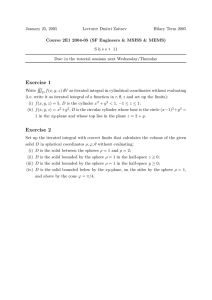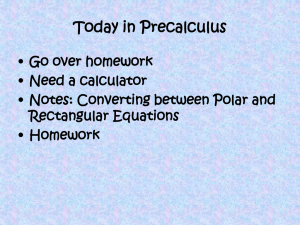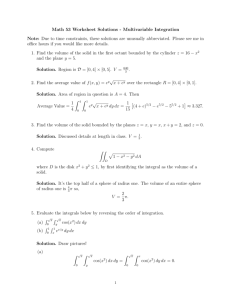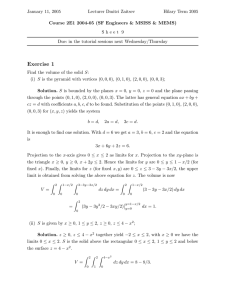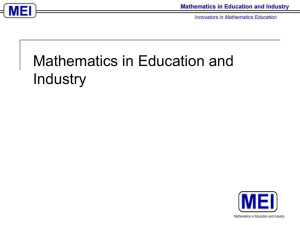January 25, 2005 Lecturer Dmitri Zaitsev Hilary Term 2005
advertisement
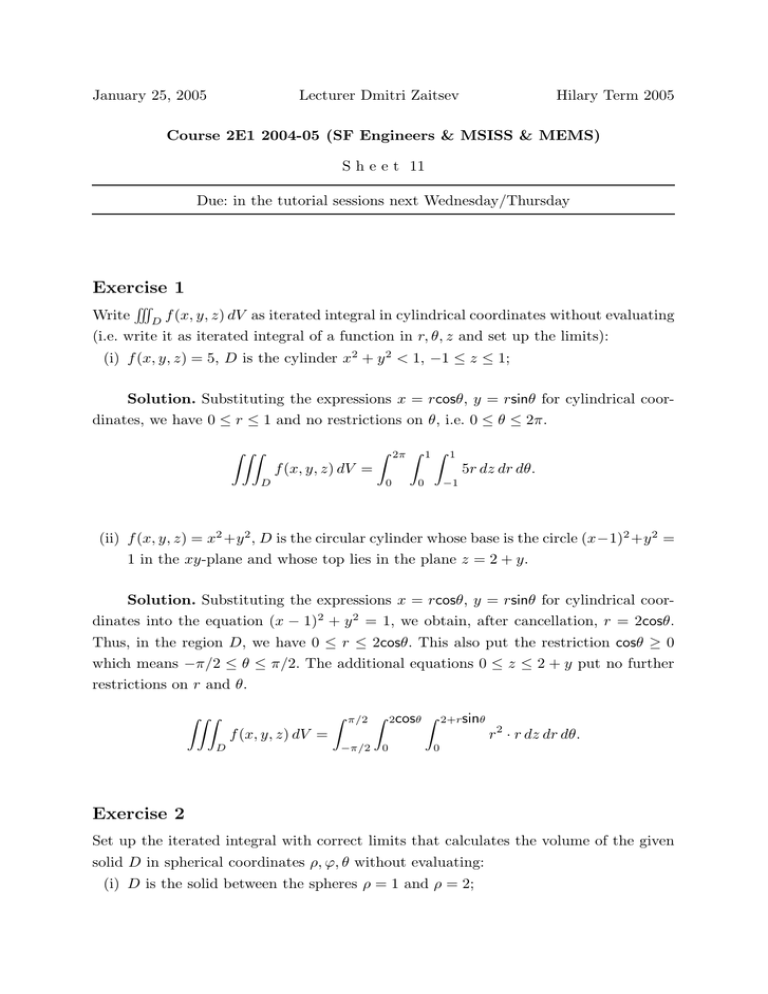
January 25, 2005 Lecturer Dmitri Zaitsev Hilary Term 2005 Course 2E1 2004-05 (SF Engineers & MSISS & MEMS) S h e e t 11 Due: in the tutorial sessions next Wednesday/Thursday Exercise 1 RRR Write D f (x, y, z) dV as iterated integral in cylindrical coordinates without evaluating (i.e. write it as iterated integral of a function in r, θ, z and set up the limits): (i) f (x, y, z) = 5, D is the cylinder x2 + y 2 < 1, −1 ≤ z ≤ 1; Solution. Substituting the expressions x = rcosθ, y = rsinθ for cylindrical coordinates, we have 0 ≤ r ≤ 1 and no restrictions on θ, i.e. 0 ≤ θ ≤ 2π. ZZZ f (x, y, z) dV = D Z 2π 0 Z 1 0 Z 1 5r dz dr dθ. −1 (ii) f (x, y, z) = x2 +y 2 , D is the circular cylinder whose base is the circle (x−1)2 +y 2 = 1 in the xy-plane and whose top lies in the plane z = 2 + y. Solution. Substituting the expressions x = rcosθ, y = rsinθ for cylindrical coordinates into the equation (x − 1)2 + y 2 = 1, we obtain, after cancellation, r = 2cosθ. Thus, in the region D, we have 0 ≤ r ≤ 2cosθ. This also put the restriction cosθ ≥ 0 which means −π/2 ≤ θ ≤ π/2. The additional equations 0 ≤ z ≤ 2 + y put no further restrictions on r and θ. ZZZ f (x, y, z) dV = D Z π/2 −π/2 Z 2cosθ Z 0 2+rsinθ r 2 · r dz dr dθ. 0 Exercise 2 Set up the iterated integral with correct limits that calculates the volume of the given solid D in spherical coordinates ρ, ϕ, θ without evaluating: (i) D is the solid between the spheres ρ = 1 and ρ = 2; Solution. We have the full ranges 0 ≤ θ ≤ 2π, 0 ≤ ϕ ≤ π for θ and ϕ and 1 ≤ ρ ≤ 2 between the spheres. V = Z 2π 0 Z π 0 Z 2 ρ2 sinθ dρ dϕ dθ. 1 (ii) D is the solid bounded by the sphere ρ = 1 in the half-space z ≥ 0; Solution. We have the full range 0 ≤ θ ≤ 2π for θ and 0 ≤ ϕ ≤ π/2 for ϕ in view of z ≥ 0 and 0 ≤ ρ ≤ 2 inside the sphere: V = Z 2π 0 Z π/2 0 Z 1 ρ2 sinϕ dρ dϕ dθ. 0 (iii) D is the solid bounded by the sphere ρ = 1 in the half-space y ≥ 0; Solution. Substituting y = ρ sinϕ sinθ in y ≥ 0 (or from the geometric considerations), we have sinθ ≥ 0 and hence 0 ≤ θ ≤ π. Note that 0 ≤ ϕ ≤ π and hence sinϕ is never negative. Finally r varies between 0 and 1. V = Z π 0 Z π 0 Z 1 ρ2 sinϕ dρ dϕ dθ. 0 (iv) D is the solid bounded below by the xy-plane, on the sides by the sphere ρ = 1, and above by the cone ϕ = π/4. Solution. Bounded below by the xy-plane means z ≥ 0, substituting z = ρcosϕ, we have 0 ≤ ϕ ≤ π/2 (note the maximal region for ϕ). Since D is also bounded above by the cone ϕ = π/4, we get the limits π/2 ≤ ϕ ≤ π/2. There are no restrictions for θ, meaning the full range 0 ≤ θ ≤ 2π. V = Z 2π 0 Z π/2 Z 1 π/4 0 ρ2 sinϕ dρ dϕ dθ.
